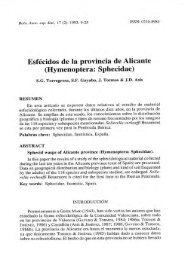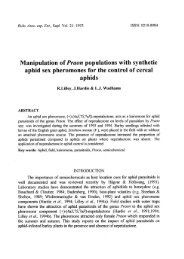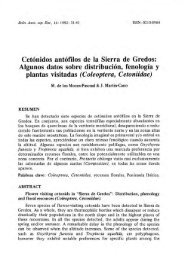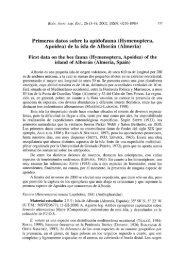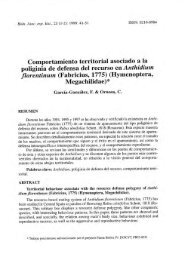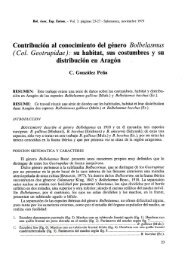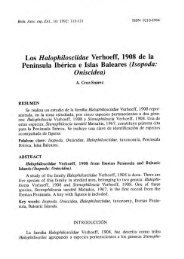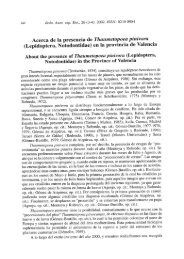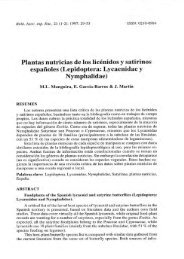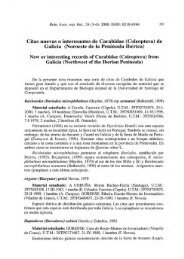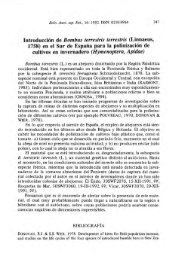Libro 1.indb
Libro 1.indb
Libro 1.indb
Create successful ePaper yourself
Turn your PDF publications into a flip-book with our unique Google optimized e-Paper software.
GALL MIDGES (DIPTERA: CECIDOMYIIDAE) OF THE IBERIAN PENINSULA 111<br />
Larvae develop in atrophied acorns of Quercus robur L. and Q. lusitanica Lam. (Fagaceae). Occurrence:<br />
very scarce (Fig. 57). Reference: TAVARES (1919). Distribution: Mediterranean.<br />
Dasineura teucrii (Tavares, 1903)<br />
Larvae cause terminal leaf bud galls on Teucrium scorodonia L., T. lusitanicum Lam. and<br />
T. salviastrum Schreber (Lamiaceae). Occurrence: frequent (Fig. 57). References: TAVARES<br />
(1903, 1905a, 1909, 1916a, 1931), COGOLLUDO (1921). Distribution: Mediterranean.<br />
Dasineura tiliae (Schrank, 1803)<br />
Cecidomyia tiliamvolvens Rübsaamen, 1889<br />
Larvae cause galls in form of rolled leaf margins on Tilia platyphyllos Scop. (Tiliaceae).<br />
Occurrence: very scarce (Fig. 58); Guimerà (Lleida, 2001) leg. Pujade-Villar. Reference:<br />
SKUHRAVÁ et al. (1996). Distribution: Euro-Siberian.<br />
Dasineura trifolii (F. Löw, 1874)<br />
Larvae cause galls – folded leaflets of Trifolium repens L. (Fabaceae). Occurrence: very<br />
scarce (Fig. 58). References: TROTTER (1902b), COGOLLUDO (1921). Distribution: Euro-<br />
Siberian.<br />
Dasineura trotteri (Tavares, 1902)<br />
Larvae cause fusiform one-sided swellings on stems of Cytisus multiflorus (L´Her.) Sweet<br />
(= C. albus Link.), C. scoparius Koch., C. striatus (Hill) Rothm. (= C. welwitschii Bss. et<br />
Reut.) (Fabaceae). Occurrence: frequent (Fig. 59). References: TAVARES (1902d, 1905a,<br />
1909, 1916a), COGOLLUDO (1921). Distribution: Mediterranean.<br />
Dasineura tubicoloides Gagné, 2004<br />
Cecidomyia tubicola Kieffer, 1889<br />
Larvae cause galls on Cytisus (Sarothamnus) scoparius L., C. striatus (Hill) Rothm. (= C.<br />
welwitschii B. R.), C. patens Webb. and C. grandiflorus Webb. (Fabaceae). The galls are<br />
formed by lateral buds which are elongate, tubular, swollen and adpressed to the stem. It<br />
is not quite clear if the same gall midge species occurs in galls of all mentioned host plant<br />
species. Occurrence: frequent (Fig. 59). References: TAVARES (1902b, 1905a, 1909, 1921).<br />
Distribution: European.<br />
Dasineura turionum (Kieffer & Trotter, 1904)<br />
Larvae are known to cause galls of two forms on Asparagus acutifolius L. (Liliaceae). The<br />
first gall form is consisted of many deformed small swollen leaves at the tip of the shoots<br />
which include inside red larvae; the second form of he gall is presented by the whole shoot<br />
which is swollen and deformed and under each of deformed thorns one larva develops. Occurrence:<br />
very scarce (Fig. 60); Matadepera (Barcelona, 1990) leg. Pujade-Villar. Reference:<br />
SKUHRAVÁ et al. (1996). Distribution: Mediterranean.<br />
Dasineura ulmaria (Bremi, 1847)<br />
Larvae cause small, smooth, rounded swellings on leaves of Filipendula ulmaria (L.) Max.<br />
(Rosaceae). Occurrence: scarce (Fig. 60). References: HOUARD (1918), COGOLLUDO<br />
(1921). Distribution: Euro-Siberian.<br />
Dasineura ulmicola (Kieffer, 1909)<br />
Larvae cause small pustule galls on leaves of Ulmus minor Mill. (Ulmaceae), with openings<br />
Boln. Asoc. esp. Ent., 30 (1-2): 93-159, 2006



